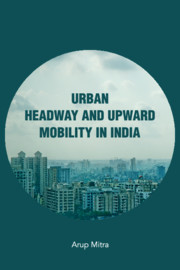Book contents
- Frontmatter
- Contents
- List of Tables
- Acknowledgements
- 1 Analytical Frame
- 2 Assessing the Quality of Cities and Towns
- 3 New Patterns and New Strategies in Indian Urbanization
- 4 Growth, Informal Sector Employment and Poverty
- 5 Upward Mobility of the Disadvantaged Sections
- 6 Erosion of the Caste Factor?
- 7 Changes in a Cultural Variable
- Bibliography
- Index
3 - New Patterns and New Strategies in Indian Urbanization
Published online by Cambridge University Press: 30 April 2020
- Frontmatter
- Contents
- List of Tables
- Acknowledgements
- 1 Analytical Frame
- 2 Assessing the Quality of Cities and Towns
- 3 New Patterns and New Strategies in Indian Urbanization
- 4 Growth, Informal Sector Employment and Poverty
- 5 Upward Mobility of the Disadvantaged Sections
- 6 Erosion of the Caste Factor?
- 7 Changes in a Cultural Variable
- Bibliography
- Index
Summary
Introduction
Though in the initial stages of development, urbanization follows as an outcome of development, subsequently it also results in development (Mills and Becker, 1986; Fujita and Thisse, 2003). One of the reasons for both being associated with each other is that with urbanization economic opportunities are expected to grow significantly for all sections of the population and thus an inclusive society is likely to emerge. The interactions among different classes at the workplace and in various facets of life may become so intense that the traditional barriers of caste, class, and religion may get dissipated, offering opportunities to those at the lower echelons to experience upward mobility. This is, of course, only a theoretical expectation, the realization of which depends on a variety of preconditions.
The advocates of balanced urbanization often oppose population concentration in a handful of large urban centres (Mills and Mitra, 1997). But it is difficult to ignore the positive outcomes of agglomeration economies associated with population concentration (Mills and Mitra, 1997). As mentioned in the preceding chapters, productivity gains are higher in large urban settlements and thus, there is a tendency for new firms to reap the locational advantages (Mitra, 1999). However, beyond a certain stage these gains tend to get neutralized and subsequently overshadowed by the increasing costs or diseconomies associated with population increase in large cities.
In the Indian context, many mega cities, which once upon a time attracted a lot of investment and accounted for a large component of economic activities, have started indicating signs of decline, possibly because they have attained the saturation limit. Thereafter, whether the next tier cities are ready to take over the lead role, substituting the role that the mega cities once played, is an important question. However, this may not always follow. A usual outcome of this is that as a large city gets saturated, new economic activities gradually come up in the rural hinterland. This is the second best solution for new firms because by being invested in these activities, they are able to avoid the diseconomies that the core city generates and at the same time they may have access (due to locational proximity) to the agglomeration economies that the core city offers. In the backdrop of this perspective we analyse the new trends in Indian urbanization, particularly the small (census) towns which have emerged between 2001 and 2011.
- Type
- Chapter
- Information
- Urban Headway and Upward Mobility in India , pp. 42 - 63Publisher: Cambridge University PressPrint publication year: 2020



